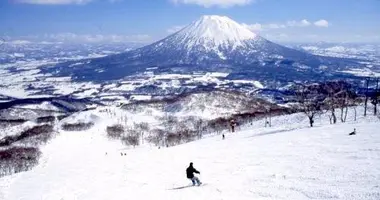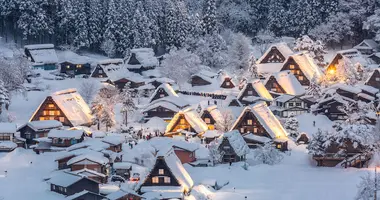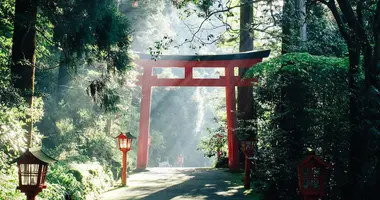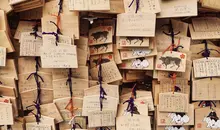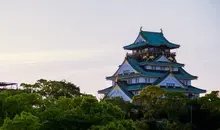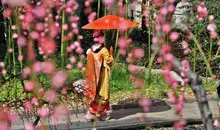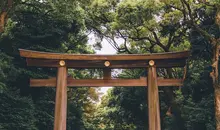Castles in Shikoku
- Published on : 21/07/2014
- by : Japan Experience
- Youtube
Shikoku Castles: see a listing of Japanese castles in Shikoku including Matsuyama Castle, Kochi Castle, Marugame Castle and Ozu Castle.
- Imabari Castle
- Matsuyama Castle
- Kochi Castle
- Marugame Castle
- Takamatsu Castle
- Uwajima Castle
- Ozu Castle
- Kyushu Castles
- Original Japanese Castles
Shikoku Castles 四国の城
Shikoku is home to a number of Japanese castles including the original castles of Kochi Castle, Marugame Castle and Uwajima Castle. Shikoku offers the chance to see a good choice of Japanese castles easily reached by public transport using a Japan Rail Pass or a hire car.
Imabari Castle 今治城
Imabari Castle, in Ehime Prefecture in Shikoku, is also one of the "three great water castles" along with Takamatsu Castle, also in Shikoku and Nakatsu Castle in Oita Prefecture, Kyushu.
Imabari Castle was built in 1602 by Todo Takatora, widely considered to be the greatest Japanese castle builder. Whereas many of the great castles he built, Fushimi, Edo, Nijo Castle in Kyoto, etc, were built for others, Imabari he built for himself.
He was awarded the fief by Tokugawa Ieyasu following the battle of Sekigahara in 1600. Prior to that Todo had two smaller domains a little further south, Uwajima and then Ozu, both castles which he built.
One of the innovations credited to Todo that can be seen at Imabari was building extra-wide moats due to the widespread use of firearms. The moat at Imabari castle could also have the water level raised or lowered by a series of sluice gates, though it is possible that Todo had access to plans of fortifications built by the Dutch in Taiwan that used this method.
Construction of Imabari Castle began in 1602 and was completed very quickly by 1604. However just a few years later the keep was dismantled and transferred to Kameyama Castle near Kyoto.
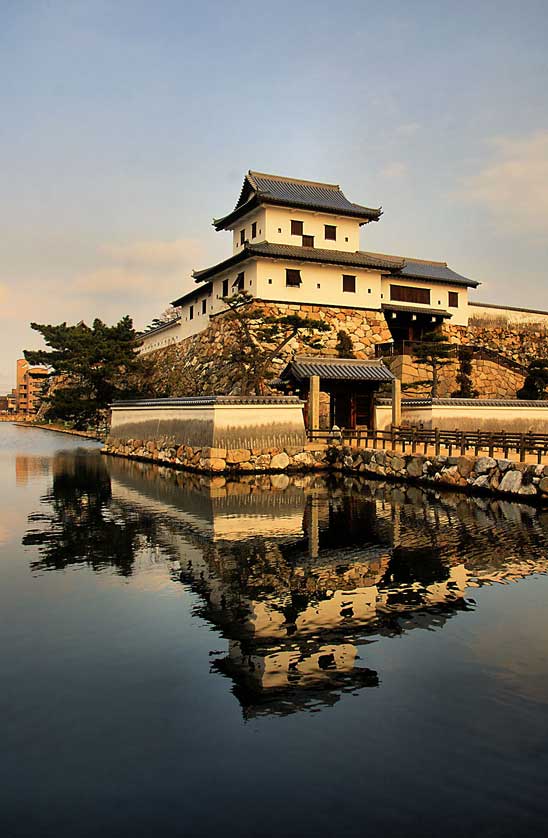 A view of the walls, moats and castle buildings of Imabari Castle
A view of the walls, moats and castle buildings of Imabari Castle
Matsuyama Castle 松山城
Matsuyama Castle,
in Matsuyama in Ehime prefecture, western Shikoku, was first built by Kato Yoshiaki between 1602 and 1627. (It is not to be confused with Bitchu Matsuyama Castle in Okayama Prefecture.)
Matsuyama Castle is one of Japan's twelve originally surviving castles, although it burnt down twice, once in 1642 and again in 1784, after being struck by lightning. The present structures date from 1854.
Iyo Matsuyama Castle is a top a steep hill called in the center of Matsuyama Koen Park, surrounded by the rest of the city. If you don't feel like the climb there is the Matsuyamajō Ropeway which is just a three minute ride to the top of the castle park.
The impressive, three-story central tower (or, donjon, daitenshu) is listed as an Important Cultural Property and has displays of samurai swords, old palanquins and armor inside which belonged to the previous feudal lords (daimyo) of Matsudaira, relatives of the ruling Tokugawa.
There are great views from the donjon over the town below and out to the Inland Sea, separating Shikoku from Honshu to the north.
The pleasant Matsuyama Castle grounds are a popular spot for cherry blossom viewing (hanami) and a good place for a picnic in summer and spring.
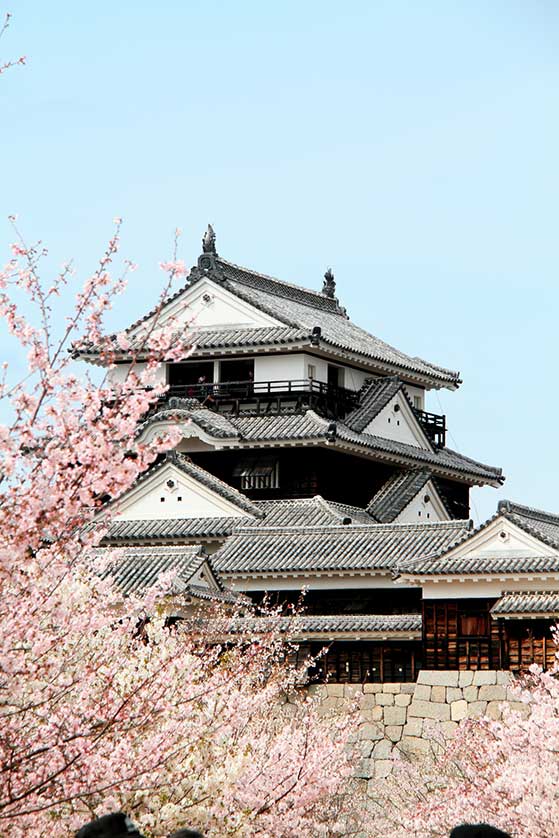 Iyo Matsuyama Castle with cherry blossom, Ehime
Iyo Matsuyama Castle with cherry blossom, Ehime
Kochi Castle 高知城
Kochi Castle in Kochi Prefecture in the south of Shikoku, is a completely original castle, one of only twelve of the hundreds of castles still standing in Japan. The complete inner citadel (honmaru) of Kochi Castle is still intact. First constructed between 1601 and 1611 by Yamauchi Katsutoyo, the feudal lord (daimyo) of Tosa, Kochi Castle burnt down in 1727 and was rebuilt between 1729-1753. The buildings you see today at Kochi Castle date from that time.
The reconstruction of the fortress in Kochi took place in the middle of a period of prolonged peace in Japan so the feudal lord of the day had his living quarters (kaitokukan) situated on the ground floor looking out on to a pleasant garden planted with cherry trees and plum trees.
The 18.5m-tall castle tower (donjon) is registered as an "Important Cultural Property" and has three external levels on six floors. On a clear day, there are good views over Kochi town stretching out below.
The Kochi Castle grounds are now known as Kochi Park and contain a number of other attractions.
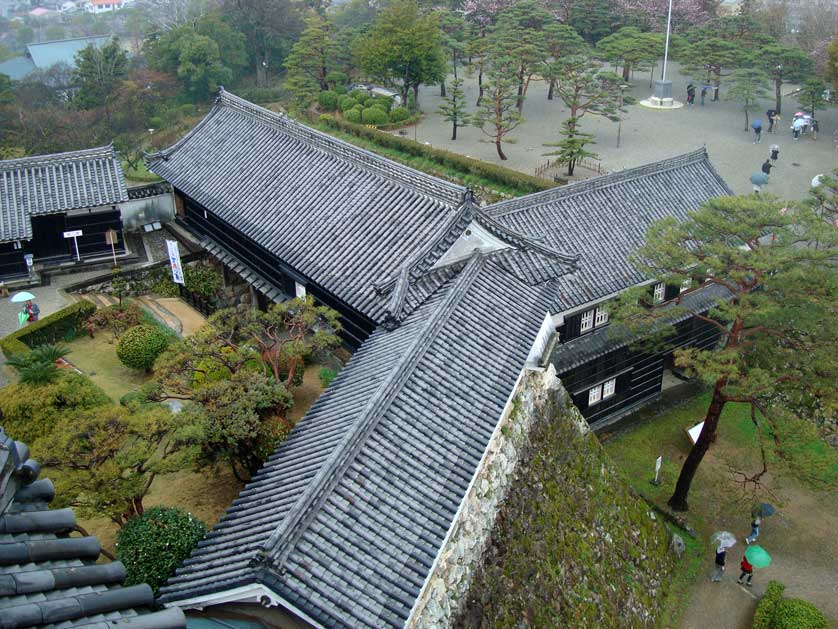 Kochi Castle in Kochi Prefecture, Shikoku
Kochi Castle in Kochi Prefecture, Shikoku
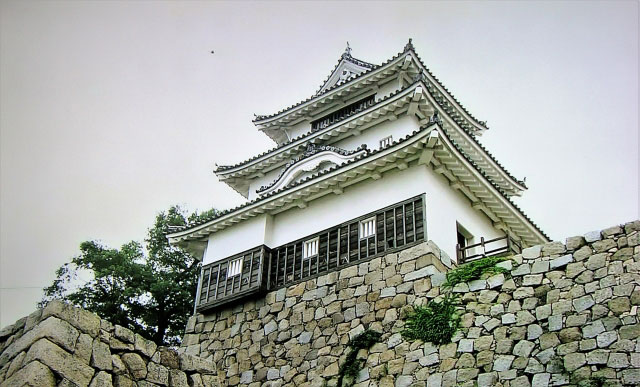 Marugame Castle
Marugame Castle
Marugame Castle 丸亀城
Marugame Castle, west of Takamatsu in Kagawa Prefecture in northern Shikoku, dates from 1597. Marugame Castle has one of only a dozen remaining original keeps (donjon) in Japan.
Perched on a hill south of Marugame town, the most impressive features of Marugame Castle are its huge stone walls rising up to 50m in parts.
The walls of Marugame Castle are known as Ougi no Kobai as they resemble the shape of a folding fan. Incidentally Marugame is known for its production of paper fans.
The pleasant Marugame Castle grounds are now a park with hundreds of cherry trees, a small zoo and a play ground for young children.
The small central tower of Marugame Castle has the usual displays of samurai helmets, photographs of Japan's other fortresses, samurai swords and armor with impressive views over the surrounding countryside and the Inland Sea, the body of water separating Shikoku from Honshu to the north.
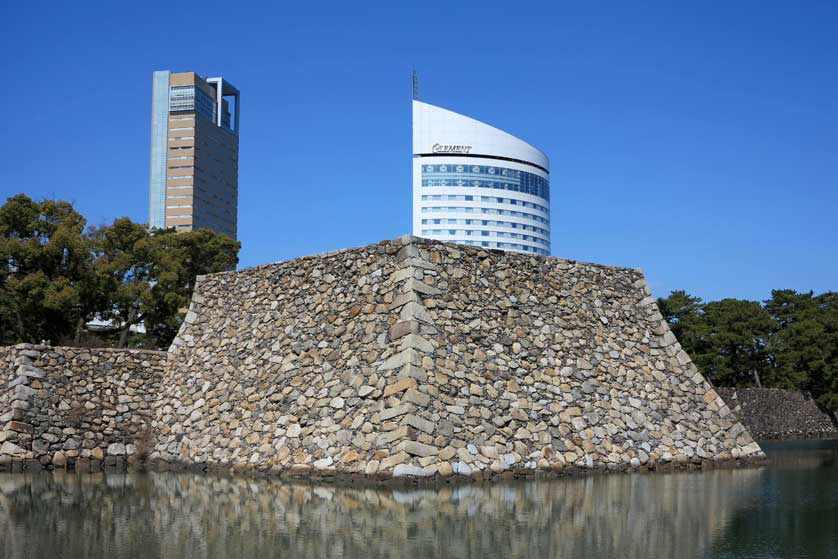 Takamatsu Castle, Takamatsu, Shikoku
Takamatsu Castle, Takamatsu, Shikoku
Takamatsu Castle, 高松城
Takamatsu Castle, also known as Tamamo Castle, is located in Tamamo Park in Takamatsu in north central Shikoku.
First constructed from 1588-1590 by Chikamasa Ikoma, Takamatsu Castle later in 1642 became a residence of the Matsudaira clan, relatives of the ruling Edo Period Tokugawa shogun.
Takamatsu Castle is of note as it faces the Inland Sea between Honshu and Shikoku islands and the moat was filled with sea water drawn in via sluice gates. Thus along with Nakatsu Castle and Imabari Castle, Takamatsu Castle makes up one of "three great water castles" of Japan.
The moat and stone walls remain along with three turrets and a gate. The Tsukimi Yagura turret facing the sea was built for moon-viewing, hence the name (tsuki = moon; mi=see) and the Ushitora Yagura is a pleasant sight as you speed by on the trains running on the Kotoden Line.
Tamamo Park has a pleasant dry, stone garden and is planted with cherry trees and pine trees.
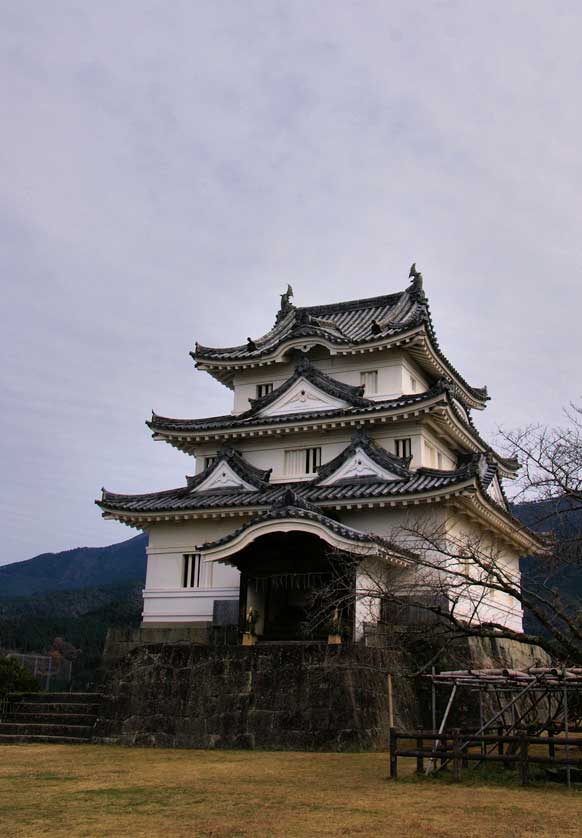 Uwajima Castle, Ehime Prefecture, Shikoku, Japan
Uwajima Castle, Ehime Prefecture, Shikoku, Japan
Uwajima Castle 宇和島城
Uwajima Castle is one of the dozen original castles in Japan and is located in Ehime Prefecture on Shikoku Island. Uwajima Castle is classified as a hirayamajiro - castle on a hill on a plain. Uwajima Castle occupies a small hill, that is now a wooded park, in the middle of Uwajima City, very close to the sea.
The castle became known as Uwajima Castle only in 1615, when the daimyo Hidemune Date, the son of the Date feudal lord in Sendai, took up governance of Uwajima domain, the domain being a reward from the first shogun of Japan, Tokugawa Ieyasu, for the Date family's contribution to victory in the Siege of Osaka, which consolidated Ieyasu's power and made him supreme.
One of Todo Takatora's design strategies, still extant, is its five-sided site. The standard castle site in Japan was square, and enemies were postulated to attack on the assumption that a site was square. Such an attack on five-sided Uwajima Castle would be likely to leave a fifth side at least temporarily free, aiding defense.
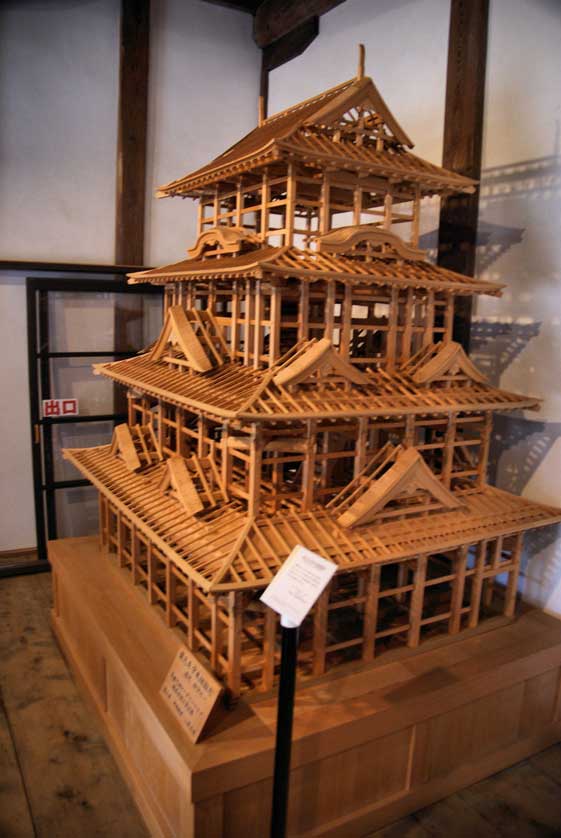 Wooden model of Ozu Castle
Wooden model of Ozu Castle
Ozu Castle 大洲城
Ozu Castle is, like most Japanese castles, a reconstruction of the original, but with an unusual difference.
Whereas most are constructed out of ferro-concrete, Ozu Castle is reconstructed out of traditional materials using traditional methods. Located on a bluff overlooking the Hijikawa River, a castle was built here in the early 14th century by Utsunomniya Toyofusa after he was appointed Governor of Iyo Province.
During the Warring States Period (mid 15th to mid 16th century) and up to the Edo Period, Ozu Castle changed hands many times and the castle's current design probably dates from the late 16th century.
The Kato Clan held the castle from 1617 until the beginning of the Meiji Period when the castle was abandoned. In 1888 the keep was torn down, but the four castle turrets, or yagura, were spared. The reconstruction was completed in 2004.
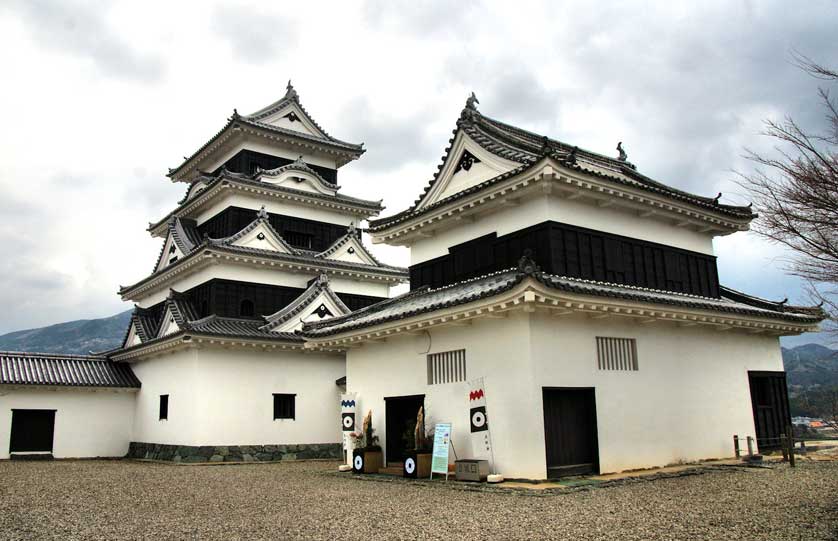 The reconstructed keep of Ozu Castle in Ehime Prefecture
The reconstructed keep of Ozu Castle in Ehime Prefecture
